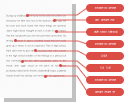批改及润色体验馆想知道您的作文、口语、文书将如何被我们的专家批改及润色吗?
 马上体验口语批改
马上体验口语批改 马上体验作文批改
马上体验作文批改 马上体验文书润色
马上体验文书润色一.以读者为中心(Become Reader-Centered)
写一篇专业论文,首先需要考虑的是读者的需要,而不是作业的需要。专业论文的读者需要很快地找到所需要的信息,论文的作业需要清晰地表达和阐述观点、理论与方法来帮助读者尽快找到所需要的信息。使用大词和漂亮词(large words,fancy/beautiful words),过于复杂地表达改变,或者提出复杂与困难的方法对于理论却不作出清晰的解释,这些方法在“Academic Writing”中都是不可取的。
中文论文作者通常不过多地介绍背景,从一个论点到另一个论点不过多地解释,多数时候作者认为读者已经或者应该理解这些,有些时候作者可能故意省去细节以避免繁琐或者显示自己的理论或方法的深奥。但是当这种写作风格被应用到“Academic Writing”时,会与论文读者的期望产生强烈的冲突。当论文评审人经常需要猜测作者想要表达的意思时(fill in blanks),尽管作者的新理论或者方法本身本身可能很有价值,论文被接受发表的几率也会非常低。好的论文应该以读者为中心组织论文结构,以便于帮助读者尽快找到重要信息,把你认为最重要的信息放在段落的开始,对于重要论点给出足够的细节说明和解释,定义关键用户和概念,利用标题和明确的转折词帮助读者跟随你的逻辑。
定义关键用语和概念是“Academic Writing”中常见的方法。可能少部分读者对着概念已经理解,但要保证大多数读者理解这些概念是非常重要的。很多好的论文作者经常以定义概念开始阐述新的论文和开始论文新的一节。定义的结构如下:
key tern / word +category / class + explanation
e.g., Debt is money that one person, organization or country owes to another.
二.避免啰嗦和使用大词(Reduce Wordiness and Large Words)
非英语母语的作者倾向于使用“大词”(large/beautiful/fancy/rare words)。这些“大词”不仅不能帮助论文显得高深,相反,会让读者非常不舒服。比如,如果作者经常使用GRE考试中的词汇,使得论文作者经常对词汇的意思产生疑问甚至需要查阅字典,这篇晦涩的论文就不太可能被发表了。
“Academic Writing”提倡清晰直接地表达观点,避免啰嗦和使用大词。在英语论文写作中,直接和清晰的风格比文采要重要得多。这对于非英语母语的论文作者来说是个好消息,因为我们可以遵循论文写作规律,运营简明清晰的英语来表达学术观点,而不必刻意追求文采。
“避免啰嗦”要求作者简化句子结构,减少不必要的字词。英语中像“basically”,“essentially”,“as a matter of fact”(这些词叫做“filler words”)这此字并没有实际意义。Academic speakers经常使用这些词,但是专业论文中要避免这些词。“in general”或者“overall”有时候可以用来代替以上的“filler words”。
可以删除“It…that…”句式。读者通常感到类似“It is interesting to note that…”的句子很啰嗦,用“Apparently”,“Because”,“The cause may be”代替这些句式可以达到更简明直接的效果。
三.首先陈述主要要点(Put Major Points First)
这和中文写作中“开门见山”的方法是一致的,将背景和细节放在主要论点之后。读者在阅读具体细节之前总是想知道文章或者段落的论点。“Academic Writing”采用一种叫做“direct,up-front approach”的方法。比如,在介绍部分或梗概部门中说明主要论点,这样读者如果对论文的观点不感兴趣,可以不再阅读后面的部分。一些国际期刊的美国评审人总结,中国学者的论文“can be compared to painting a picture. The main points(pictures)slowly emerge as more and more details are added. Finally, by the end of the paper, the full picture is revealed and the reader understands the message(overall picture).”运用这种写作风格写专业论文是达不到理想效果的。相比之下,标准的美式学术论文,要求首先描绘一个微型的整体架构图,说明该论文的写作目的、主要论点、文章结论,然后再从头至尾,详细介绍背景和细节。
这个“开头提出主要论点”的写作原则在英文信件和e-mail中同样有效。美国的论文作者通常第一句话就进入主要内容,如果有必要的话,接下来再介绍背景,而很少在e-mail中以背景介绍开始“My name is”或“I am from…”。
在“Academic Writing”中,主要论点叫做“thesis statement”。按照许多其他国家包括中国的写作风格,“thesis statement”通常在论文中间或者文章最后的结论(conclusion)中,但是美国模式的“Academic Writing”
的“thesis statement”总是出现在开头(introduction)部分,而且经常是“开篇第一句”。
非英语母语作者除了经常违背“首先提出主要论点”的原则,还倾向于使用很长的介绍句子,以下几个原则可以帮助大家克服这个毛病。
规则1:Place the most important (main) subject and/or clause at the beginning of the sentence to emphasize the main message.
规则2:Avoid the tendency to place prepositional and other long phrases that indicate time (or even adverbs that indicate time) at the beginning of the sentence.
英语中严格定义的过去/现在/将来时态应该得到充分、有效的利用、以下例句以强调“Currently”,“In the past”作为开始,打不到好的效果,因为“Currently”,“In the past”在句子中没有任何必要,显得很累赘,甚至会让读者感到很迷惑,因为句子本身的时态已经足够表达清楚了。
Currently,the company is planning to move its operations to Beijing.
In the past,companies have been too cautious about moving into new markets.
规则③ Avoid the tendency to place prepositional and other phrases that indicate comparison at the beginning of the sentence; avoid beginning the sentence with the purpose,condition,location or reason before stating the main idea.
这是因为把这些短语放在句首会把句子的“main point”推迟到句尾。为了强调“main point”,达到直截了当的效果,不要推迟“main point”的出现。
·Compared to native writers of English, most non-native writers tend to be more indirect.
Revised: Most non-native writers tend to be more indirect than (or compared to) native writers of English.
·In order to avoid prosecution, the defendant lied to the jury.
Revised: The defendant lied to the jury in order to avoid prosecution.
Due to the severity of the storm, many residents boarded up their houses.
Revised: Many residents boarded up their houses due to the severity of the storm.
另外“For the sake of”,“If/When phrases”,“As a consequence of”也是
经常被过多食用的开头短语。
论文作者需要知道如何强调论点才能有效地表达研究结果,为了充分强调重要信息,请体会和借鉴如下方法:
方法① Omit or reduce the amount of less important information. Provide less important information only if it is necessary for understanding the key points. The more“noise”,the more difficult it is to focus on the message.
方法②Use dependent clauses to subordinate less important information.
For example:
Weak: Jupiter has an enormous size and gravity (background),and so the Galileo probe steadily gained velocity as it approached the planet(main point)
Improved: Because Jupiter has an enormous size and gravity (background), the Galileo probe steadily gained velocity as it approached the planet (main point).
“after,although,as,because,before,despite,even though,since,when,while”都是常用的从属连词。尽管上面两个例句中信息的顺序不一样的,但是改进的句子提供了一个理解论点的原因,而原来的句子让读者感到所强调的是“Jupiter is large”。
方法③ Tell readers what information is important(or less important)
For example:
The most important finding of this study is…
One of the most important findings of our study is…
The most unusual aspect of…is…
There were no important changes in…
方法④ Repeat important information.
重要信息应该多次重复,这样读者在跳读过程中能够领会到论文的重要论点。重要信息可以在以下部分重复和强调:title;abstract;discussion(perhaps twice in this section ---in the beginning and again at the end);individual paragraphs (stated as atopic sentence at the beginning of the paragraph and as a concluding idea at the end of the paragraph)
方法⑤ Avoid burying important information in the “middle of a sentence or paragraph, where it becomes invisible to the reader.
Power positions:
at the beginning of a sentence, paragraph, or section(most common option)
at the end of a sentence ,paragraph, or section
Weak positions:
in the middle of a sentence ,paragraph, or section
Words in parentheses
Adjective or noun in the middle of a sentence
方法⑥ Avoid weak references by overusing “it is considered that…”,”it is important to note that…””it has been suggested that…”or similar phrases that take the focus away from the message.
e.g.,It has been considered that this method assesses explicit memory…(Bauer,1995;Mandler,1990;Meltzoff,1990;Bauer&Mandler,1992)
Revised: This method assesses explicit memory…
Or: Several researchers have used this method to assess explicit memory…
四.避免使用谦虚、礼貌、恭敬用语(Avoid Words of Humility, Modesty,Politeness, and Esteem )
英语专业论文不应该出现表示谦虚和赞扬的用语,当然也不能使用刻薄讥讽的词汇,作者需要对他人的相关工作进行客观的评价,但是无论是正面还是反面的评价,都应该保持中肯的态度,避免使用表示极端态度的用语。“American academic writing”的写作风格直接(straight forward /direct),这与美国人的性格特点是一致的。比如当写一封道歉信时,美国人会在开头表示道歉,“We are sorry for making a mistake in your bill and we will be happy to refund the difference to you.”然后直接说明解决问题的方法,在道歉信的结尾,会有类似这样的句子“Again, please accept our apologies for mistake, and we hope that this solution will correct the situation.”道歉很简短,而且不会在信中反复强调,因为这对于解决问题并没有太大的作用。同样,表示谦恭的用语在普通的“American Writing”中也很少见,类似如下这些表达是不可取的:“Your esteemed company/university…”,“I humbly request…”、“Smith’s work is beyond comparison.”因为这样非但没有庄重和尊敬的感觉,反而让美国人感到很滑稽,当然,这并不意味着我们应该采取生硬的命令口吻,比如:“You will do such and such…”
五.写作要具体(Write Specifically and Concretely)
比喻、举例、解释、定义在“American writing”中都是有效的方法;相反,抽象和含蓄的写作手法是不可取的。当你用例子来说明一个论点时,美国读者希望见到“for example…”这样的字眼。举例之后非英语母语的作者往往认为无需再做解释,读者应该已经理解了例子与论点之间的关系,但是“This example illustrates the theory of relativity by…”这样的句子是不可缺少的。尽管这些逻辑关系对于作者来说是很明了的,但是你需要向美国读者明确地说明这是个例子,以及这个例子是如何与论点相关的。
论文写作要使用具体语言,避免含糊不清的句子。模糊或者抽象的句子会让读者感到迷惑,无法理解你的论点。而使用具体实际的细节,可以吸引读者的注意力,并且能帮助读者想象并解释稳重讨论的内容。作者可以使用举例、数字、名字、列举原因、给出具体解释等方法使论文显得具体,避免含糊抽象。
为了证明一个论点,作者应该提供足够的具体信息来支持这个论点。很多美国教授抱怨说:“Non-native writers do not seem to‘ prove’ their points. They expect the professor to‘fill in the details’.”非英语母语的作者通常认为教授对这个领域已经非常了解,没有必要陈述过多的细节。然而,在“Academic Writing”中,足够的论据能体现批判性思维(critical thinking)和思维的深度(depth of thinking)。这些具体的论据必须是充足、可靠的。强有力的论据包括:
英文伦恩成功写作
·Statistics
·Experimental data
·Direct observation(“According to my experience in the XXX Company…”)
·Opinions (with logical explanation ---how you arrived at that personal conclusion)
·Expert testimony (“According to the head of the Environmental Protection Agency…”Not used as often in science or engineering, but used often in business and social sciences.)
·Specific examples---often with details(Instead of “Distribution has decreased,” it is better to say, “Distribution has decreased by 20% in the past 2 years causing a loss of $25,000”)
作者需要清洗地引导读者理解各个论点和它们之间的逻辑关系,“给读者留下想象空间”的写作风格在飞英语母语作者写的论文中很常见,但这是非常不可取的。为了让论文的调理(flow)清晰,从而使读者跟随你的思路并理解你的论点,转折词和短语能起到很大作用,常用的转折词和短语包括:“however”,“in contrast”,“for example”,“in addition”,“while/whereas”“although”,“because”等。我们稍后在第二章中将详细讨论转折词的使用。
六.表现批判性的思维(Show Critical Thinking)
在专业论文的“Introduction”部分,作者需要对其他学者的相关工作作出评价,如果对于他人的工作指示点到为止,或者是一味赞扬,会让论文的读者感到很不舒服。表现出准确的判断力和批判性思维是非常重要的。在美国教授的课堂上,教授经常要求研究生阅读和研究知名学者的论文或理论,然后写出一篇批判性的报告(critique),仅仅重复作者的观点或者表示同意、赞扬是不够的。社会学科和经济学教授经常给出案例,研究生需要作出有创新的分析和解决方案。很多国家的文化传统告诉作者对地位比自己搞的学者的工作作出负面的评价是不合适的,但是美国教授通常认为有创造性的见解是在分析和直译他人的工作的过程中形成的。
Writing Research Papers 创作专业论文
Title
准确地反映论文的内容和主题,一目了然,而且要尽可能吸引读者的注意力。
·Include the topic of the study—do not make the title so creative that readers do not know what the topic of your research is.
·Include the scope of the study.
·Make it easy to understand without reading the paper first.
·Include key words so it is easy to categorize and find in searchers.
·Follow standard capitalization for your field(e.g., Rarely all capital letters)
Abstract
提供论文的概述,提出论文的论点和精华,也可以包括重要的细节。
·Background: introduce the topic(optional)
·Purpose of the study:“The purpose of the study is…”
·Methods of the study: overview of the methods
·Findings/Results of the study: overview of the main results
·Conclusions, implications or significance of the study(optional)
Introduction
介绍论文所要讨论和解决的问题,向读者交代与问题相关的背景,评述相关工作,简略说明论文所采用的方法和贡献,以吸引读者的注意力。
·Establish the topic: General statements about the area of research being focused on—establishing the narrowed research topic.
·Literature review: Specific statement about the aspects of the problem already studied by other researchers—establishing what has been done so far in previous work
·Investigation needed(Gap): Statement that indicate the need for more investigation beyond the current research—establishing the “gap” or need for further research in a particular area
·Purpose of your research: Very specific statement giving the purpose/objectives of your study. It might also directly state your hypothesis.
·Value of your research: Optional(some indirect) statement that give the value or justification for carrying out the study or what it will contribute to the field
·Outline: Optional statement about how the paper is organized
Methods
描述方法的细节,使用的材料,实验的步骤,理论的推导过程等等。
·Describing population of people, facts or on-going truths.
·Describing samples or sample groups.
·Describing conventional materials or equipment
·Describing specially designed or modified materials or standard materials used in this study.
Results
展现研究工作的新发现、新理论、新成果,并对成果提供简要评论。
·May begin with an overall description of the experience, providing the “big picture” without repeating all the experimental details.
·Present representative data(results relevant to the question) rather than endless repetitive data.
·Keep data to a minimum in the text. Save these details for the figures.
Discussion
具体解释研究的成果,说明这些成果意味着什么,根据这项研究成果,其他的同行能够学习、领悟到什么。
·Review the original hypothesis or focus of the study
·Review the principle findings and support whether or not they support the original hypothesis.
·State or restate the limitations the major interpretations of the findings.
Conclusion
总结论文主要内容、所讨论的问题、主要方法和成果,可以指出下一步的研究方向和任务。
 马上体验口语批改
马上体验口语批改 马上体验作文批改
马上体验作文批改 马上体验文书润色
马上体验文书润色北京创新伙伴教育科技有限公司是国内一家留学一站式服务品牌,以出国考试,留学申请和海外服务为核心,为用户提供一站式的留学服务。并以翻转课堂为产品核心,基于自主研发的 SMART 智能教学系统,打造 "学、练、改、测、评" 的陪伴式“管”式动态学习,全面覆盖线上、线下和移动学习以及五大出国考试。